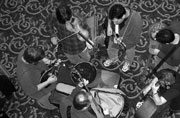THE 3,500 PEOPLE who passed through the lobby of the Tacoma Sheraton last weekend were exposed to a type of sonic chaos that isn’t heard anywhere else. Every corner of the hotel’s immense three-story lobby was crammed with circles of devotees communicating in the common language of bluegrass music. The ad hoc ensembles all played different songs at various speeds, creating a swirling cacophony in the middle of the room. This may seem like a bizarre scene for a hotel lobby; last weekend, though, the Sheraton belonged to Wintergrass.
Started in 1993, Tacoma’s Wintergrass has become cause for an annual pilgrimage among those who share a passion for a music that dates back to the late 1930s, when a Kentuckian named Bill Monroe put together the seminal Blue Grass Boys. Monroe and his contemporaries created a canon of songs that today is regarded as gospel by musicians and fans. Wintergrass is only one of hundreds of bluegrass festivals staged across the country, in increasing numbers of late. What separates Wintergrass, however, is not only its season (most festivals take place in the summer) but its size and the relative intimacy that is achieved on such a scale. Colorado’s Telluride festival sells three times as many tickets, and North Carolina’s Merlefest may feature more all-star jams, but no festival offers as much ‘grass for the dollar as Tacoma’s indoor event, where a weekend pass went for $80.
This year the festival’s five stages juggled shows by national acts such as Tim O’Brien and the Nashville Bluegrass Band with local favorites like 78 RPM and the Ohop Valley Boys. Countless workshops, jam sessions till sunrise, and a veritable marketplace of stringed instruments made Tacoma an all-you-can-stomach smorgasbord of acoustic music. And Wintergrass is still growing. At one point during the sold-out opening night festivities, the emcee at the main stage announced that the capacity crowd was the largest in Wintergrass history. The audience let out a bittersweet cheer, proud to have watched the festival succeed from its humble beginnings, but with the knowledge that such mass appeal will inevitably change its character. This time, it was almost too successful—many ticket holders were denied admission to several Friday performances when organizers closed the doors to avoid fire code violations.
WHILE MANY FORMS of folk music are hastily being archived by the Smithsonian before its practitioners have all passed on, bluegrass is a living organism. Its simple form is so accessible that there’s almost no distinction between listener and player. Monroe’s original recipe is constantly being revamped in the hands of those who get hooked on its fast tempos and high, lonesome harmonies.
Although many attended Wintergrass to see bands perform, an equal number showed up mostly to exchange tunes and to meet others who share an addiction to the twang. One of the few oral traditions left in the Digital Age, bluegrass music shows no signs of obsolescence.
A quick glance at the Wintergrass crowd revealed the reason for its sustained growth—the festival attracted fans from multiple demographics. The oldest festivalgoers were fans of the original bands that defined the sound in the ’40s and ’50s. The baby boomers discovered bluegrass during the ’60s, when Monroe, the Stanley Brothers, and Flatt and Scruggs were coaxed out of virtual obscurity by the Northern college kids who organized the first festivals. A strong showing of dreadlocks is a testament to the influence of Jerry Garcia and other hippies who brought bluegrass tunes into the popular vocabulary throughout the ’70s and ’80s. The youngest fans in attendance were turned on by either bluegrass-crazed parents or bands who have incorporated the style into pop music, such as the Dixie Chicks and Dave Matthews. It wasn’t uncommon last weekend to witness a jam session with three or four generations of musicians represented.
THE CENTERPIECE of Wintergrass was the reunion of mandolinist David Grisman’s original David Grisman Quintet, which hadn’t played together in over 20 years. The group’s eponymous 1978 album was one of the first to marry bluegrass with a jazz sensibility and classical virtuosity. Each member has since gone on to individual acclaim, and the Wintergrass show proved emotional for both band and audience. Violinist Darol Anger, guitarist Tony Rice, mandolinist Mike Marshall, and bassist Todd Phillips joined Grisman for a song-by-song recreation of their revolutionary recording. In its day, the DGQ album caused a stir among bluegrass purists, who saw its innovation as a sacrilege. It’s telling that, 23 years later, the renegade group would headline a major festival.
In fact, this year’s entire Wintergrass lineup reflected the current diversity of the bluegrass scene. In addition to an array of traditional and modern bluegrass, the festival featured Celtic, Cajun, and old-time bands. Sure, the environs of the fancy Tacoma Sheraton may have seemed a little sterile for a music that’s more aligned with creeks and campgrounds, but that’s part of the irony that has kept people coming back year after year. By the time Sunday night rolled around, many sleep-deprived Wintergrassers had already ordered tickets and reserved rooms for next year’s festival.





